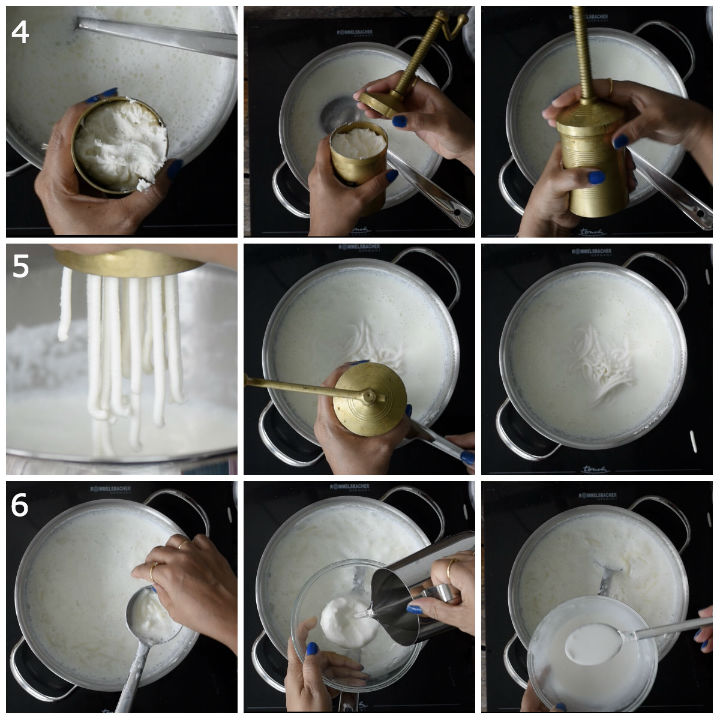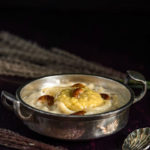 Happy Dasara/Vijayadasami to all my readers :). Today, I am going to share the famous Palathalikalu Recipe, a traditional Andhra sweet prepared for festivals or special occasions. Generally these palathalikalu are offered as Naivedyam or Prasadam to lord Ganesh on Ganesh Chaturthi. But, we also prepare it for Dasara and Sankranti festivals. Though there are many variations and ways to make this payasam, this is how my grandmother and my mom used to prepare.
Happy Dasara/Vijayadasami to all my readers :). Today, I am going to share the famous Palathalikalu Recipe, a traditional Andhra sweet prepared for festivals or special occasions. Generally these palathalikalu are offered as Naivedyam or Prasadam to lord Ganesh on Ganesh Chaturthi. But, we also prepare it for Dasara and Sankranti festivals. Though there are many variations and ways to make this payasam, this is how my grandmother and my mom used to prepare.
What is Palathalikalu?
“Pala” meaning MADE WITH MILK and “Thalikalu” meaning NOODLES are prepared with rice flour in the shape of long cylinders. These are then cooked in thickened milk, sweetened with Jaggery, flavoured with cardamom and finally garnished with fried nuts. One can make thalikalu by using a Muruku/sev press using the big holed disc or make the rice string cylinders by hand which is time consuming. Whichever method you adapt, they shouldn’t break into tiny pieces or melt into the payasam….So, the consistency of the dough you prepare is very important!!
Off to Palathalikalu Recipe!!
Which Rice Flour should I use to prepare Palathalikalu?
Though Homemade Rice Flour yields best results, you can also use store bought one. But, in this case, it may happen that the Thalikalu (Rice Noodles) may turn out slightly hard.
How to prepare Rice Flour at home?
To make rice flour, first wash and soak rice for at least 3 to 4 hours, drain out all the water and fan dry on a clean cloth until there is no wet in rice. Grind into fine powder and sieve the flour.
You can use this rice flour for Palathalikalu, Janthikalu, Kudumulu, Murukulu, Ribbon pakoda and many more snacks….and coarse rice rava left out after sieving can be used to make Undrallu, upma, kheer and so on..
Click HERE to get detailed instructions on How to make rice flour at home. You can prepare rice flour in advance and store it in the refrigerator for up to a month or two.
No patience or time to prepare? Then, go ahead with store bought rice flour!!
Prep Work:
- Get the rice flour ready for the recipe.
- Wash sago, completely drain out the water and set aside for 15 minutes.
- Remove skin and crush a few cardamom pods to a fine powder.
- Chop, grate or powder jaggery and set aside. You can directly use jaggery if it doesn’t have any impurities. But, to be on the safer side, it’s always recommended to make a syrup, strain and then use.
Palathalikalu Recipe Step by Step Process:
1- How to make Jaggery Syrup?
Dissolve jaggery powder in half a cup of water. Bring it to a boil to one string consistency or Gulab Jamun syrup consistency. Strain the syrup, cool down and use it later.
2- Heat milk in a thick bottomed vessel or pan over medium heat and bring it to a boil.
3- Preparing Thalikalu or Rice Noodles:
Combine the rice flour, a pinch of salt and a teaspoon ghee in a wide bowl.
Add boiling milk little by little to the flour, mix very well with a spatula and make a soft dough. Allow it cool for a couple minutes then knead it well. The dough should be soft and smooth.
Now, back to the payasam. Lower the heat and add the sago to the boiling milk.

4- Grease the inside of a Jantikalu or Muruku press, place disc with big holes and fill it with the prepared dough. Close the Muruku press with its lid. If you don’t have a muruku press, then grease your hands with little ghee and divide the dough into small balls & shape into cylindrical shaped 2 inch long strips.
5- When to add Thalikalu to Milk?
Milk starts boiling and sago turns transparent. This is when you add the dough strips to the boiling milk.
When you press the mould, the dough should come out easily as shown in the video. Now, press the muruku press and drop the rice flour strings (thalikalu)
directly into boiling milk in a circular motion. Do not stir immediately. Let it boil for 2 minutes otherwise the noodles may disintegrate.
6- Cook for 10-12 minutes and check for doneness.
Dilute a teaspoon of rice flour or the left over dough along with a pinch of cooking soda in some water. Mix it well completely and make sure there is no lumps. Once noodles are cooked, add diluted rice flour mixture to the milk and cook for 2 -3 minutes and turn off the heat.
Why do we need to add cooking soda while cooking with milk and jaggery?
Adding a pinch of cooking soda to rice flour or milk will prevent milk from curdling when you combine with jaggery. So, whenever you combine milk with jaggery in any recipe, a pinch of cooking soda will do the magic.

7- Add the prepared jaggery liquid and mix well. Keep stirring till it mixes well.
8- Add cardamom powder.
9- Toast some cashews a teaspoon ghee until golden brown. Add it to the payasam along with the remaining ghee and mix well.
Serving Suggestions:
- Offer to the God as Neivedyam during any festival or enjoy it as a dessert while it is still hot.
- This payasam thickens when cold due to rice flour. If you want a slightly runny consistency, skip adding diluted rice flour in step 6.
- The traditional way to serve Palathalikalu is along with Mudda Pappu and a dollop of Ghee.
Other Payasam Recipes you might like:

Palathalikalu Recipe Step by Step | Bellam Thalikalu With Rice Four
Ingredients
For Jaggery Syrup:
- 3/4-1 Cup grated Jaggery
- 1/2 Cup Water
For Thalikalu:
- 3/4 Cup Rice Flour use freshly home made
- 1/2 Cup Boiling Milk, or as required to make dough
- A pinch of Salt
- 1 tsp Oil/Ghee
For Payasam:
- 4 Cups Milk, divided (1/2 Cup to mix for rice flour dough)
- 2 tbsp Sago, Saggubiyyum (Wash & set aside for 15 min.)
- 1 tbsp Rice flour, or the thalikalu dough
- A Pinch of Cooking Soda
- 1/2 tsp Cardamom powder
- 10-12 Cashews & Raisins, fried until golden brown in 1 teaspoon Ghee
Instructions
PREPARATION:
- Boil the grated jaggery along with water until 1 string consistency. Keep aside until use.
- Make the rice flour to a soft dough by adding sufficient boiling milk.
- Make the dough cylindrical shape and fill it into the muruku maker, close the lid. Set aside until use.
METHOD:
- Bring the milk to a boil.
- Add sago and stir in between for 8- 10 minutes. The sago turns transparent.
- Press the muruku maker in a circular motion and drop the rice flour strings directly into boiling milk.
- Let it stand for a few minutes without stirring.
- After a few minutes, stir and cook for 10-12 minutes till the thalikalu gets cooked. The cook time depends on the thickness of the thalikalu.
- Dilute a tablespoon of rice flour or the left over dough with a pinch of baking soda in some water. Add 2-3 Tbsp of this rice flour mixture to the payasam and cook for 3-5 minutes and turn off the heat.
- Finally, add prepared cooled jaggery syrup, cardamom powder and fried cashew nuts and raisins .
- Serve when hot.
Recipe Video
Notes
- For best results, use Homemade Rice Flour.
- Adjust sweetness to suit your taste...it will not affect the taste of the Payasam.
- The jaggery syrup should not be too thick or too thin.
- This payasam thickens when cold due to rice flour. If you want a runny consistency, skip adding diluted rice flour in step 6.
- Serve while it is still hot.
- The traditional way to serve Palathalikalu is along with Mudda Pappu and a dollop of Ghee.
Hope you enjoyed Palathalikalu Recipe !!
I have tried to answer a few possible queries one might get while preparing this recipe. If you have any further questions or suggestions, please feel free to drop in the comment box!!
Check out other FESTIVAL RECIPES and DESSERT RECIPES from blog.
Also check out other Navaratri Recipes below:
- Rava Kesari Bath
- Rava Puri or Sojjappalu
- Mango Kesari or Sheera
- Bobbatlu or Puran Poli
- Coconut Obbattu
- Kobbari Poornam
- Rajma Sundal
- Allam Garelu
Hungry for more? Never miss a recipe!!…Subscribe to MasalaKorb and have posts delivered straight to your inbox! And connect with me on Facebook, Google, Twitter, Instagram and Pinterest for all of the latest updates.
Do subscribe to my YouTube Channel for latest video alerts!!
Did you make a recipe? Make sure to tag your photo with this hashtag: #masalakorb
Happy Cooking
Cheers!!
Padma.




